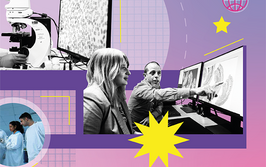It Takes a Village
Each and every link in the chain from sample to patient outcome is indispensable

The phlebotomist greets his patient with a smile. He knows people generally dislike getting their blood drawn, so he goes out of his way to make each patient’s experience as pleasant as possible. He does his job quickly and efficiently, always putting his current patient at ease. He double-checks the labels on the samples before sending them to the lab for processing.
The laboratory assistant is the first to notice when the laboratory information system (LIS) goes down. She helped write the updated downtime procedures, so she is quite familiar with them. An unscheduled computer downtime can be hectic, but she knows that, if she executes the procedures and communicates well, patients will still receive the correct results in a timely manner.
The bench technologist stretches his back as he dons a new pair of gloves. Today, he’s performed preventative maintenance on multiple analyzers, updated several departmental procedures, performed quality control and quality assurance measures to verify all test results, and answered an internist’s questions regarding a specific patient’s results. It’s been a productive day and he leaves the laboratory feeling satisfied about his contributions to patient care.
The pathologist reviews her patient’s history in the LIS before peering into a microscope to examine the patient’s biopsy. Although it’s sobering to diagnose someone with cancer, today it’s also gratifying, because she’s able to diagnose a Grade 1, minimally invasive breast lesion and also compare it with the molecular profile and circulating tumor cell results rendered from the blood samples drawn earlier. Now, her patient can be effectively treated – and likely cured. Later, she’ll speak with her patient’s surgeon and offer to meet with the patient if needed. Tomorrow, in addition to her diagnostic duties, she’ll review the new immunohistochemistry procedures and explore the possibility of ordering new differential panels before giving a lecture to the new surgical pathology residents.
The laboratory director starts her day by meeting with the managers and supervisors, where she’s updated on equipment needs, budget concerns, and personnel issues. Next, she meets with the medical director, where they discuss the timeline for updating testing methodology. That afternoon, she meets with administrators from other departments to discuss a recent hospital-wide inspection; when she’s congratulated on the laboratory’s perfect marks, she mentions the names of several staff members who worked hard to make it happen. Later, she’ll try to find money in the budget to throw the lab a modest “we passed our inspection” party. She sometimes misses working in the heart of the laboratory, but she enjoys being in a position to advance patient care while serving as a leader and rewarding her staff for a job well done.
Every day, laboratory professionals of all backgrounds, educations, and job titles perform their duties with remarkable grace, efficiency, and accuracy. Although in recent years, the laboratory has begun to climb out of the proverbial basement and into the center of health care, it can be hard to appreciate just how integral each and every position is to ensuring uncompromising patient care. For example, for a patient to be appropriately diagnosed with acute lymphocytic leukemia, a phlebotomist must confidently identify the correct patient and draw their blood; a laboratory assistant needs to receive the specimen and send it to the proper department; a medical scientist hematologist must ensure that the instrument is functioning within reproducible parameters before samples are analyzed and is tasked with recognizing when results are abnormal; the pathologist relies on these results as well as the additional samples produced to render her diagnosis; and the laboratory director must ensure that the entire system runs on time and on budget. Removing any step from this complex equation could significantly compromise patient care. The mission of the laboratory community is to provide efficient and unquestionable results so that patients can receive optimal care. Doing so requires commitment – interdependent commitment of the entire laboratory team. And this is why we at ASCP live by the mantra of “Stronger Together.”
CEO of the American Society for Clinical Pathology




















